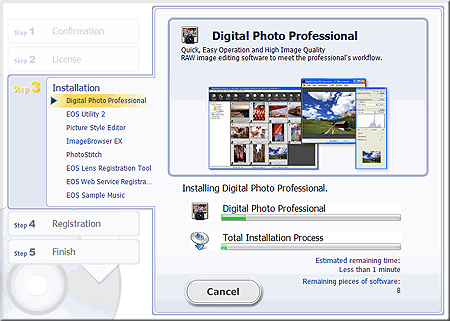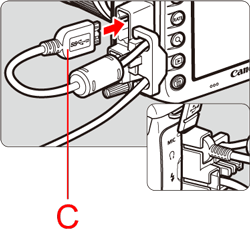Solution
Preparing to Import Images to a Computer (Software Installation)
You can use the software on the 'EOS DIGITAL Solution Disk (CD-ROM)' that came with your camera to import images you have taken to your computer.
For more information on individual software applications, please refer to the 'Related information' section at the end of the page.
CAUTION
- Never connect the camera to your computer before you install the software. The software will not be installed correctly. Also, make sure to check the software system requirements against the specifications of your computer.
- Install ImageBrowser EX from the CD that came with your camera even if ImageBrowser EX is installed already on the computer you are using. You can update to the optimal version that supports the features of the camera you are using. You can also add new features using the Auto Update feature.
- Use the procedure below to install software other than ImageBrowser EX as well when an older version is installed (the installation will overwrite the previous installation).
1. Turn your computer on.
2. Insert the EOS DIGITAL Solution Disk (CD-ROM) into the computer.
If the following window appears, click [Run SETUP.EXE].
If you are using a Macintosh computer, double-click the CD-ROM icon on the desktop, and then double-click [Canon EOS Digital Installer].
3. Select the area in which you live.
4. Select the country where you live, and then click [Next].
6. Click [Easy Installation] (to install all applications included on the Solution Disk).
For a Macintosh computer, click [Install].
NOTE
7. Close any other applications, and then click [OK].
9. Read the license agreement and if you agree to the terms, click [Yes] to begin the installation.
If you do not select [Yes], it will not be possible to install the software.
10. When using EOS DIGITAL Solution Disk Ver.25 or later, the screen below will appear on computers connected to the internet. If you agree to the disclaimers, click [Yes].
11. If the following screen appears, please read the license agreement and if you agree to the terms, click [Yes] to begin the installation.
If you do not select [Yes], it will not be possible to install the software.
12. If the following window appears, click [Yes].
13. The following window appears, and installation starts.
14. If a screen similar to the one shown below is displayed, click [OK]. Proceed with the installation by following the on-screen instructions for the required operations.
16. The following screen appears. In this example,

[No, I will register later.] has been selected, and

[Next] has been clicked.
To register your camera on CANON iMAGE GATEWAY, select [Yes, I would.], and follow the instructions to complete registration.
19. Remove the CD once the computer restarts.
NOTE
Refer to the link below if the software cannot be installed:
Connect the Camera to the Computer
1. Confirm that the camera is not connected to the computer, and then set the camera's power to <ON>.
2. Press the <MENU> button to display the menu.
3. Change the camera's Auto power off settings.
3-1. Press the <

> button and select the [

] tab.
3-2. Turn the <

> dial to select the [

] tab.
3-3. Turn the <

> dial to select [Auto power off], then press <

>.
3-4. Turn the <

> dial to select [Disable], then press <

>.
Please refer to the Instruction manual supplied with your camera for more information about the Auto power off settings.
4. Press the <MENU> button to turn off the display on the LCD monitor, and then turn the camera's power to <OFF>.
5. Connect the supplied interface cable to the camera.
IMPORTANT
Use the provided interface cable or one from Canon. When connecting the interface cable, use the provided cable protector. Using the cable protector prevents the cable from accidental disconnection and the terminal from getting damaged.
5-1. Remove the clamp (A) from the cable protector.
5-2. Open the terminal cover, and attach the cable protector to the interface area of the camera.
5-3. Attach the clamp you removed in step 5-1 as shown in the image below.
5-4. Connect the cable to the digital terminal with the plug’s <

> icon (C) facing the back of the camera.
6. Connect the cord’s plug to the computer’s USB terminal.
The location of the terminal varies by computer model. For more information on the location of the terminals on your computer, please refer to its instruction manual.
NOTE
If no connection is recognized between the camera and computer even when they are connected as described in the procedure, please refer to the link below:
Download Images to the Computer
1. Set the camera's power switch to <ON>.
2. Communication between the camera and the computer begins.
Click [

] in the task bar to display the following screen.
Click [EOS Utility] to start EOS Utility.
When the camera and computer become capable of communicating, EOS Utility will start.
3. The main window for EOS Utility appears.
To download all images saved in the memory card, click [Starts to download images] in the EOS Utility window.
By default, the downloaded images are sorted into folders by their shooting date, and are saved in the [Pictures] folder on the computer. If you wish to change the destination for the downloaded images, click [Preferences] and specify the settings in the dialog box.
NOTE
4. The images are downloaded to the computer.
5. When all the images have been downloaded, Digital Photo Professional starts and the downloaded images are displayed.
When downloading images, you can change the associated software from Digital Photo Professional to ImageBrowser EX. Click [Preferences] on the main screen of EOS Utility to set the association on the dialog box that is displayed.
Confirming the Images Downloaded to the Computer
Images downloaded to your computer are displayed as a thumbnails list in the main window.
By default, folders are created by shooting date. When you select the folder with the shooting date that you want to confirm, a list of the images recorded to this folder is displayed.
REFERENCE
- Images displayed with the [
 ] icon are movie files and cannot be played back in Digital Photo Professional. Please use ImageBrowser EX, which is compatible with EOS DIGITAL movie files.
] icon are movie files and cannot be played back in Digital Photo Professional. Please use ImageBrowser EX, which is compatible with EOS DIGITAL movie files.
- If the message [Insufficient memory] appears, there are too many images in one folder. Decrease the number of images in one folder such as by dividing them into smaller folders.
You can double-click an image to open the edit window and display the image at large size.

Edit window

Tool palatte














 [No, I will register later.] has been selected, and
[No, I will register later.] has been selected, and  [Next] has been clicked.
[Next] has been clicked.




 > button and select the [
> button and select the [  ] tab.
] tab.

 > dial to select the [
> dial to select the [  ] tab.
] tab.

 > dial to select [Auto power off], then press <
> dial to select [Auto power off], then press < >.
>. 

 > dial to select [Disable], then press <
> dial to select [Disable], then press < >.
>. 



 > icon (C) facing the back of the camera.
> icon (C) facing the back of the camera.


 ] in the task bar to display the following screen.
] in the task bar to display the following screen.



 ] icon are movie files and cannot be played back in Digital Photo Professional. Please use ImageBrowser EX, which is compatible with EOS DIGITAL movie files.
] icon are movie files and cannot be played back in Digital Photo Professional. Please use ImageBrowser EX, which is compatible with EOS DIGITAL movie files.
 Edit window
Edit window Tool palatte
Tool palatte